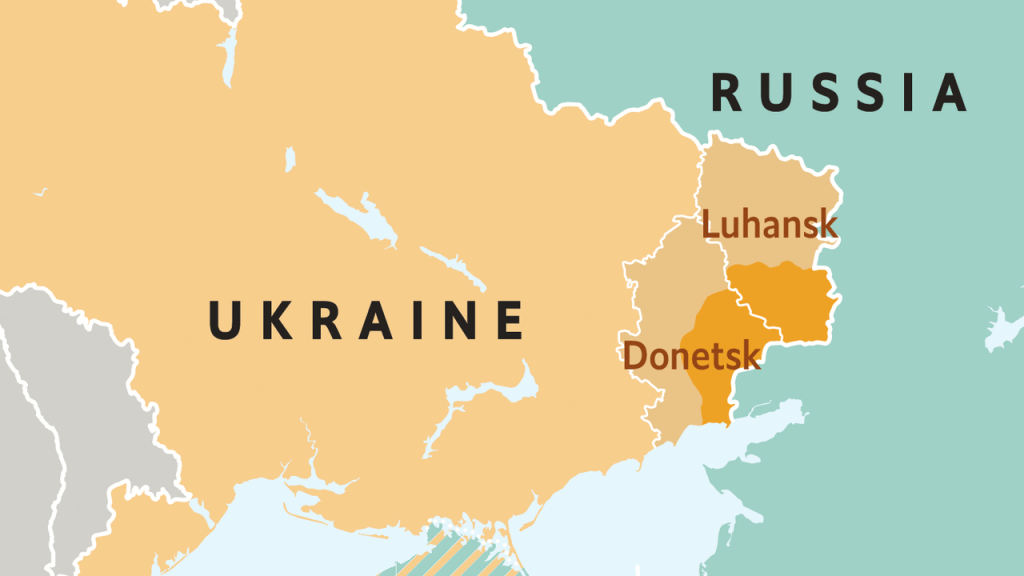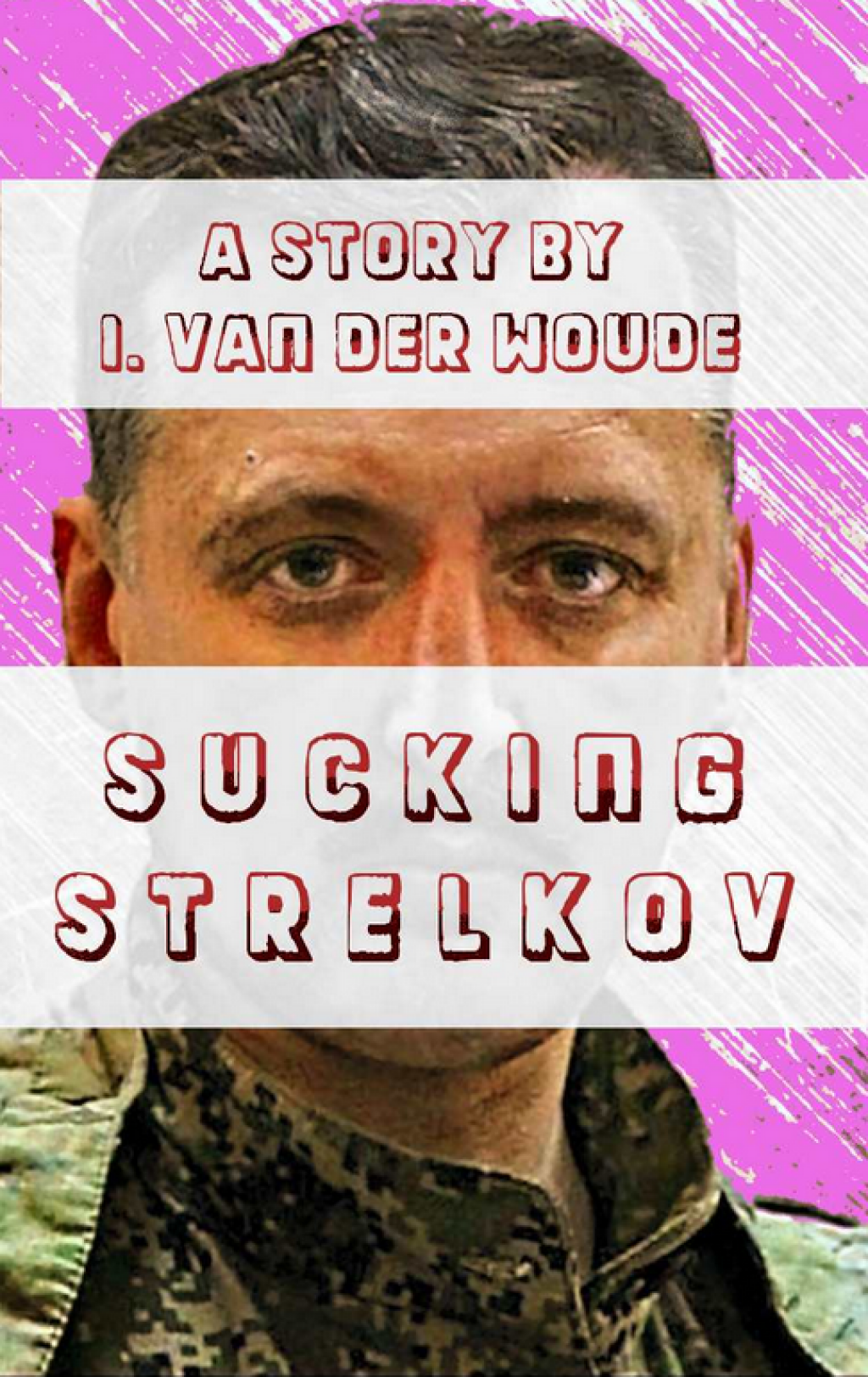We at the Jordan Center stand with all the people of Ukraine, Russia, and the rest of the world who oppose the Russian invasion of Ukraine. See our statement here.
Above: a map showing Donetsk and Luhansk in Eastern Ukraine.
Nikolay Mitrokhin is a Research Fellow at the University of Bremen. His current research project is on ideological groups inside the ROC in Russia and Ukraine after 2012. He is currently providing real-time updates on the war in Ukraine in Russian on Facebook and Telegram.
Some of my Russian Facebook friends are seriously discussing the Putin narrative that claims that, over the past eight years, the Ukrainian military has subjected civilian populations in the so-called Donetsk and Lugansk People’s Republics to constant shelling. Some of those discussing Putin’s line that “For eight years they sat there in cellars under fire!” were not yet old enough to follow politics as of 2014. Others seem to have forgotten a few key facts.
There is no such thing as the "peoples of Donbas and Lugansk."
Since 2014, this ideological construct has been funneled into the consciousnesses of Russians and Ukrainians via all available Kremlin propaganda channels. Yet over eight years later, the two relatively small administrative entities that supposedly represent the whole project remain divided, separated by customs and police checkpoints alike.
In the not-so-distant past, the populations of the two Ukrainian regions called Donetsk and Luhansk was very mixed. People living there held more than one set of identifications, where pro-Ukrainian sympathies (more typical for the northern parts of Luhansk and the western and southern parts of Donetsk) clashed with the more pro-Russian sympathies of the mining and industrial towns and the rural (Don cossack) population of the southern part of Luhansk oblast.
According to sociological surveys, about a third of the region's population expressed an unambiguous desire to join the Russian Federation or for some form of federalization. That was before any fighting. Another third supported greater integration between Ukraine and Russia without moving any borders or changing any statuses. The remaining third wanted to preserve the status quo within an independent Ukraine — this category included politically active Ukrainian patriots, of which there were quite a few in Donetsk itself. In short, pro-Russian enthusiasm and organization in the region only existed in certain settlements, while in others it was simply absent.
At first, the Ukrainian authorities and later the Ukrainian army found support in those regions — as was the case in Debal'tseve.
The pseudo-referendum on the creation of these "people's republics" was conducted in just a few towns and cities located mostly around the Donetsk metropolitan area, using only a small fraction of the polling stations that would normally operate during a vote. What proportion of the population actually took part in the referendum is simply unknown because there was no external verification of the count (not that any was even proposed).
There was no "popular uprising" in the region.
No more than approximately 30-35 thousand people took part in pro-Russian rallies in Donetsk, a city with millions of residents. No more than 1.5-2 thousand people from each large city participated in the storming of government buildings or later joined the ranks of the "people's police." The vast majority of these people hailed either from small-town gangs like the Stakhanovskaya, an organization at the very root of Lugansk "statehood," or were Russian citizens looking to undermine Ukrainian statehood from February 2014 forward, preparing the ground for many future "field commanders" in the same vein.
Until June and July 2014, most cities in the Donbas region had a functional Ukrainian government represented by mayors and state councils, which existed in parallel to the activities of groups declaring themselves defenders of the "People's Republics."
The fighting in the Donbas began on Russia's initiative.
Russia armed and deployed across the border the so-called "Crimea unit," led by Igor Girkin (alias Strelkov), a retired FSB lieutenant colonel and a specialist on "Chechen" matters before his foray into "Ukrainian" ones. The Crimea unit mostly consisted of veterans of the GRU special forces and other Russian army special combat units trained in sabotage — read terrorist — activities.
Girkin was no ordinary FSB officer. He was closely connected to the militant terrorist underground of armed Russian nationalists (including, indirectly, with the neo-Nazi terrorist group BORN) and to the so-called “black diggers” of the illegal arms market, so much so that he moderated an online forum dedicated to these topics. Following the storming of government buildings in the city of Slavyansk, he initiated fighting with Ukrainian law enforcement agencies, and later with the Ukrainian army itself — starting with an ambush shooting of Ukrainian Security Service officials who had arrived in the city to investigate the situation.
The shelling of Slavyansk began after Girkin used self-propelled Nona mortars, seized from the Ukrainian army, to fire upon enemy positions.
Nona, along with other weapons that began to flow into the city — partly from seized Ukrainian supplies, partly delivered by the Russian army — were fired from residential neighborhoods in Slavyansk. Return fire led to shells hitting homes, with all the attendant death and destruction. City residents had ample opportunities to evacuate in any direction, even on public transport.
I am here omitting an account of the whole war of summer 2014 and early 2015. During that period, the Ukrainian armed forces sought to liberate their country’s territory from bands of self-described "field commanders" who had flown there from every end of the former USSR and even distant foreign countries. These "field commanders" did their best to use urban infrastructure to inflict maximal damage on the Ukrainian army. According to his accomplice, Alexander Zakharchenko, Girkin even proposed blowing up multi-story apartment buildings along the roads into Donetsk to make it more convenient to set up defenses.
Later, activists investigating the explosions in Moscow and other Russian cities in 1999 found an uncanny resemblance between а police sketch of the terrorist seen placing bags of RDX in an apartment building in Ryazan and a portrait of Girkin that became popular in 2014. In 1999, Girkin was an FSB officer fighting Salafi jihadist terrorism in the North Caucasus — first in Dagestan, then in Chechnya — so this theory is tantalizing, albeit unconfirmed.
Finally, people have forgotten — or simply never knew — what happened after most fighting ceased in early 2015.
True, the Ukrainian army and the Russian-controlled "people's militia corps" of the "people's republics” periodically exchanged artillery fire even after that point. The dividing lines between them followed the borders of the urban areas surrounding the cities of Donetsk and Luhansk (not to be confused with the borders of the Donetsk and Luhansk administrative regions); between the densely populated urban areas under the control of the Luhansk-Donetsk People’s Republic, on one side, and, on the other, the more sparsely populated suburbs and countryside under Ukraine's control. Meanwhile, Ukraine still controlled two thirds of the territory of both the Donetsk and Luhansk administrative regions.
Firing from urban buildings led to return fire. At the same time, the artillery shells and rockets from the “people’s republics” frequently landed in Ukraine-controlled cities and villages. Besides the well-known Russian shelling of residential neighborhoods in Mariupol and Kramatorsk, during the fighting Russian artillery constantly barraged Avdeevka, the first city west of Donetsk that was controlled by the Ukrainian army, Stanitsa Luhansk, a northern suburb of Luhansk under Ukrainian control, and many other places.
Still, the intensity of urban shelling was relatively low, with both sides aiming primarily at military targets. The people who supposedly “sat in cellars for eight years” during the fighting were residents of the front line, who for some reason or other were unable or did not wish to evacuate. 98% of the population lived more or less normal lives, per the authorities of the people's republics themselves.
In 2014-2015, however, they endured expropriation and terror at the hands of their new Russian-supported government. The takeover of this part of Ukraine by criminal gangs lining up under the banner of national self-defense led to the largest spate of robberies in post-Soviet history. Anyone of any means was at risk as squabbling warlords stole money, cars, even homes. But property crimes were far from the end of the affair: many victims were subjected to torture and humiliation in stinking pits nicknamed "basements," where they were kept while their relatives scrambled to secure ransom. Many people died, and those who escaped often lost their health in the ordeal.
The history of the bloodiest of the gangs involved, the Bryanka-USSR, is freely available on the internet. These "special units" patrolled the rear areas under the control of the Luhansk People’s Republic, but were only one of dozens of similar groups, most of which disappeared without a trace. Many "field commanders" and militants died around Donetsk at the hands of their own associates and ideological comrades. Only by 2017 did some semblance of normal life return, albeit with the continued suppression of all political opposition and ongoing violent skirmishes and murders. Meanwhile, the so-called "power vertical" divvied up the spoils.
Three people who will not be attending the celebrations that mark the Russian Federation’s recognition of the Lugansk People’s Republic are its first three heads of state. Officially, Gennady Tsypkalov hanged himself in a cell in Lugansk in 2016; Valery Bolotov died of a heart attack in Moscow in 2017; and Igor Plotnitsky resigned from office in 2017. Unofficially, Tsypkalov was strangled, Bolotov was poisoned at a meeting with the former Speaker of the Parliament of the People’s Republic, while Plotnitsky was removed from office in an armed coup. Arrested in Russia, this final figure was never heard from again.
On the other hand, the head of the Lugansk People’s Republic, retired Ukrainian Security Services Colonel Leonid Pasechnik will be in attendance. Pasechnik spent the entire period of hostilities in 2014 in the territories controlled by Ukraine, and only decided to make a career in the People’s Republic as of October 2021. The situation with recent leaders of the Donetsk People’s Republic is eerily similar: mafiosi who the Kremlin bet on in an attempt to give the impression of a "popular uprising" in the Donbas, many of them have died as violently as they lived. All did their best to destroy one another for five years after the zone of lawlessness had come into being in eastern Ukraine.
Under Russian management, the economic situation in the "people's republics" quickly deteriorated. With zero enforcement of property rights, money and goods were simply stolen and redistributed. Factories and mines, once sources of regional pride, were taken apart and sold to Russia on the cheap. The few workers who remained at their posts found their meager salaries unpaid for six months at a time. What little income this once-prosperous region produced was funneled into the pockets of Moscow bureaucrats and oligarchs.
At least a third of the population, and possibly up to half, picked up and moved out of the region, with some relocating to Ukraine and others to Russia. Life there had simply become too dangerous — not only because of the shelling, but also because of the atrocities the "conquerors" perpetrated and the cessation of normal economic life.
Those still living in the "people's republics" certainly deserve protection — the question is, from whom?
Translated by Joseph Livesey
Joseph Livesey graduated with a BA from the School of Slavonic and East European Studies, University College London. He holds an AM in Russian, East European, and Central Asian Studies from Harvard, and graduated last year with a PhD in Anthropology from NYU.



